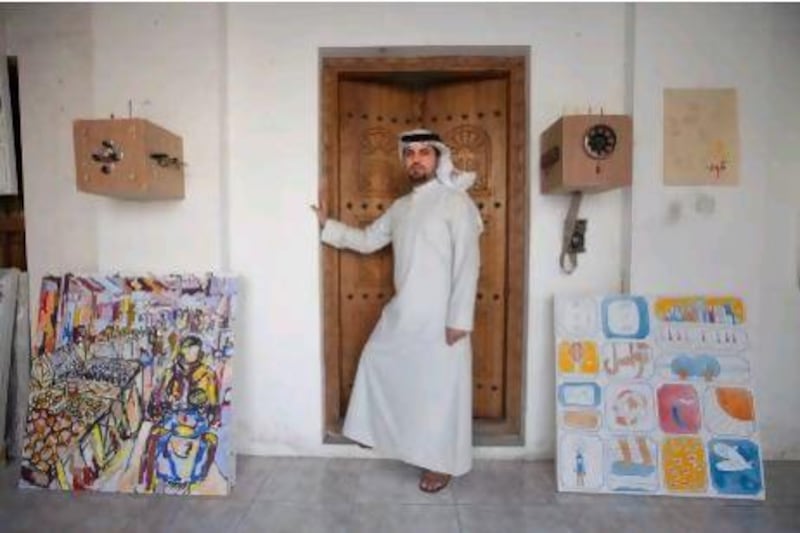Nasir Nasrallah holes up in Beit Al Shamsi whenever he can. He has a narrow space in this evocative old courtyard of rooms in the Heart of Sharjah, and shares the building with 14 other artists selected to work there by the city's Department of Culture and Information.
Ploughing through page after page of notebooks and dividing his time between cartoonlike narratives and more classical paintings that depict the raucous colour of a fruit market, the Emirati artist has a multitude of techniques on the boil at any one time.
"Every piece I do gives me some experience for future artworks," says Nasrallah. "I don't want to stop any of the styles of work that I'm doing now."
The process
Trained as a telecommunications engineer, Nasrallah's techie background has fed his adoration for the mechanical.
"I want to pull apart machines and know how a mechanism works," he tells us. "You can apply mechanics to any part of life; even your personal life can be thought of as a machine."
This has led to a series of drawings that depict a chaotic mass of interwoven machinery - some ultra-complex assembly line designed for the most mediocre of task – for instance, a good cup of coffee.
In March, Nasrallah unveiled a series titled Useless Machines at the Sikka Art Fair – myriad domestic knick-knacks cobbled together to form a hybrid installation – entirely useless, he tells us, but a catalyst for some curious responses from the audience.
He points to an assemblage of gears, circuity and exposed wiring. "Someone told me this could be a machine for controlling the weather. It all depends on each individual's experience of the elements in the machine," he explains.
Nasrallah's participation in Sikka rounded off a three-month artist residency with AiR Dubai, a programme initiated between Art Dubai, Dubai Culture and Arts Authority, the studio hub Tashkeel and the Delfina Foundation. Working alongside five other artists – a mix of local and international names – Nasrallah says the experience showed him the storytelling potential of installation. "It was a chance to work with different materials and have the space to play around with new ideas."
The working week
Previously an engineer for Etisalat before the workload overwhelmed his opportunities for time in the studio and forced him to quit, Nasrallah now balances a job at the Department of Culture and Information with his art.
"We organise activities every Monday, with film screenings and workshops for both children and adults. I'm responsible for Beit Al Shamsi as well," he says.
"But I still manage to get into the studio twice a week and at weekends. It would be hard to just concentrate on my art because I have a family, and I took a job to pay the bills. But if I had the opportunity then I would go full-time on it, definitely."
Nasrallah's early studies at the Emirates Fine Arts Society, the country's oldest art collective, has had a profound effect on his practice. He was tutored by some of the UAE's foremost artists, such as Mohammed Kazem and Ebtisam Abdulaziz. "I feel it's my place," he says. "My artistic ambitions really started here."
The inspiration
Provoking stories in his audience is a key facet of what Nasrallah is trying to do: "I don't want anyone to feel pushed to read my work in any particular way."
He's been invited to participate in the Sharjah Biennial next year with a large-scale version of his Story Converter – a black, covered box in which the audience is invited to place their hand and scribble down a secret on a piece of card inside.
"I will take these cards and 'convert' them into drawings," says Nasrallah. He did a similar work at Sikka Art Fair this year, and says it was successful and a good source of material for his work. "I had more than 50 responses just on opening night."
The artist has also started work on his first children's book – illustrated, written and published by him.
Getting seen
"I've not really explored the option of getting my work into one of the commercial galleries in Dubai, mainly because of the lack of time," he says. "But I have exhibited with the Emirates Fine Art Society before at Sharjah Art Museum and sold work."
Nasrallah says that the development of the scene in Dubai is encouraging and is impressed with the talent emerging from a younger generation of Emirati artists. But he remains committed to Sharjah and the fine art group that was established more than 30 years ago: "I was born here as an artist."
For more on Nasir Nasrallah's work, visit www.nasir.ae.





